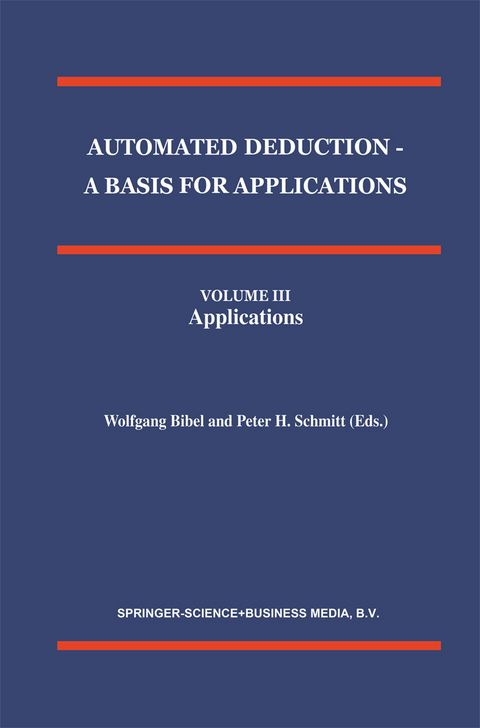
Automated Deduction - A Basis for Applications Volume I Foundations - Calculi and Methods Volume II Systems and Implementation Techniques Volume III Applications
Seiten
2010
|
Softcover reprint of hardcover 1st ed. 1998
Springer (Verlag)
978-90-481-5052-6 (ISBN)
Springer (Verlag)
978-90-481-5052-6 (ISBN)
We are invited to deal with mathematical activity in a sys tematic way [ ... The field of automated deduction has witnessed considerable progress and in the last decade, automated deduction methods have made their way into many areas of research and product development in computer science.
We are invited to deal with mathematical activity in a sys tematic way [ ... ] one does expect and look for pleasant surprises in this requirement of a novel combination of psy chology, logic, mathematics and technology. Hao Wang, 1970, quoted from(Wang, 1970). The field of mathematics has been a key application area for automated theorem proving from the start, in fact the very first automatically found the orem was that the sum of two even numbers is even (Davis, 1983). The field of automated deduction has witnessed considerable progress and in the last decade, automated deduction methods have made their way into many areas of research and product development in computer science. For instance, deduction systems are increasingly used in software and hardware verification to ensure the correctness of computer hardware and computer programs with respect to a given specification. Logic programming, while still falling somewhat short of its expectations, is now widely used, deduc tive databases are well-developed and logic-based description and analysis of hard-and software is commonplace today.
We are invited to deal with mathematical activity in a sys tematic way [ ... ] one does expect and look for pleasant surprises in this requirement of a novel combination of psy chology, logic, mathematics and technology. Hao Wang, 1970, quoted from(Wang, 1970). The field of mathematics has been a key application area for automated theorem proving from the start, in fact the very first automatically found the orem was that the sum of two even numbers is even (Davis, 1983). The field of automated deduction has witnessed considerable progress and in the last decade, automated deduction methods have made their way into many areas of research and product development in computer science. For instance, deduction systems are increasingly used in software and hardware verification to ensure the correctness of computer hardware and computer programs with respect to a given specification. Logic programming, while still falling somewhat short of its expectations, is now widely used, deduc tive databases are well-developed and logic-based description and analysis of hard-and software is commonplace today.
1 Lattice-ordered Groups in Deduction.- 2 Superposition Theorem Proving for Commutative Rings.- 3 How to Augment a Formal System with a Boolean Algebra Component.- 4 Proof Planning: A Practical Approach to Mechanized Reasoning in Mathematics.- 5 Program Synthesis.- 6 Termination Analysis for Functional Programs.- 7 The WAM Case Study: Verifying Compiler Correctness for Prolog with KIV.- 8 Using Automated Theorem Provers in Verification of Protocols.- 9 Theorem Proving in Large Theories.- 10 Analyzing Rule Sets for the Calculation of Banking Fees by a Theorem Prover with Constraints.- 11 Deduction-Based Software Component Retrieval.- 12 Rewrite Based Hardware Verification with ReDuX.
| Erscheint lt. Verlag | 9.12.2010 |
|---|---|
| Reihe/Serie | Applied Logic Series ; 10 |
| Zusatzinfo | XII, 335 p. |
| Verlagsort | Dordrecht |
| Sprache | englisch |
| Maße | 160 x 240 mm |
| Themenwelt | Geisteswissenschaften ► Philosophie ► Allgemeines / Lexika |
| Geisteswissenschaften ► Philosophie ► Logik | |
| Mathematik / Informatik ► Informatik ► Software Entwicklung | |
| Informatik ► Theorie / Studium ► Algorithmen | |
| Informatik ► Theorie / Studium ► Künstliche Intelligenz / Robotik | |
| Mathematik / Informatik ► Mathematik ► Allgemeines / Lexika | |
| Mathematik / Informatik ► Mathematik ► Angewandte Mathematik | |
| Mathematik / Informatik ► Mathematik ► Logik / Mengenlehre | |
| ISBN-10 | 90-481-5052-3 / 9048150523 |
| ISBN-13 | 978-90-481-5052-6 / 9789048150526 |
| Zustand | Neuware |
| Haben Sie eine Frage zum Produkt? |
Mehr entdecken
aus dem Bereich
aus dem Bereich
Buch | Softcover (2024)
Lehmanns Media (Verlag)
39,99 €
IT zum Anfassen für alle von 9 bis 99 – vom Navi bis Social Media
Buch | Softcover (2021)
Springer (Verlag)
29,99 €
Interlingua zur Gewährleistung semantischer Interoperabilität in der …
Buch | Softcover (2023)
Springer Fachmedien (Verlag)
32,99 €


